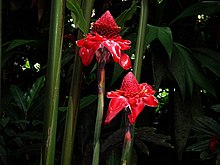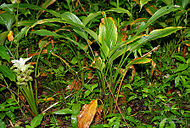Zingiberaceae
This article includes a list of general references, but it lacks sufficient corresponding inline citations. (September 2013) |
| Ginger family | |
|---|---|

| |
| Red torch ginger (Etlingera elatior) | |
| Scientific classification | |
| Kingdom: | |
| (unranked): | |
| (unranked): | |
| (unranked): | |
| Order: | |
| Family: | Zingiberaceae |
| Type genus | |
| Zingiber Boehm.
| |




Zingiberaceae (/ˌzɪndʒɪbəˈr[invalid input: 'ay']s[invalid input: 'ee']/) or the ginger family is a family of flowering plants made up of about 50 genera with a total of about 1600 known species[2] of aromatic perennial herbs with creeping horizontal or tuberous rhizomes distributed throughout tropical Africa, Asia, and the Americas.
Many of the family's species are important ornamental, spice, or medicinal plants. Ornamental genera include the shell gingers (Alpinia), Siam or summer tulip (Curcuma alismatifolia), Globba, ginger lily (Hedychium), Kaempferia, torch-ginger Etlingera elatior, Renealmia, and ginger (Zingiber). Spices include ginger (Zingiber), galangal or Thai ginger (Alpinia galanga and others), melegueta pepper (Aframomum melegueta), myoga (Zingiber mioga), korarima (Aframomum corrorima), turmeric (Curcuma), and cardamom (Amomum, Elettaria).
Characteristics
Members of the family are small to large herbaceous plants with distichous leaves with basal sheaths that overlap to form a pseudostem. The plants are either self-supporting or epiphytic. Flowers are hermaphroditic, usually strongly zygomorphic, in determinate cymose inflorescences, and subtended by conspicuous, spirally arranged bracts. The perianth is composed of two whorls, a fused tubular calyx, and a tubular corolla with one lobe larger than the other two. Flowers typically have two of their stamenoids (sterile stamens) fused to form a petaloid lip, and have only one fertile stamen. The ovary is inferior and topped by two nectaries, the stigma is funnel-shaped.
Some genera yield essential oils used in the perfume industry (Alpinia, Hedychium).
Distribution
The Zingiberaceae have a pantropical distribution in the tropics of Africa, Asia, and the Americas, with their greatest diversity in Southeast Asia.
Taxonomy
- Subfamily Siphonochiloideae
- Subfamily Tamijioideae
- Subfamily Alpinioideae
- Tribe Alpinieae
- Aframomum - grains of paradise
- Alpinia - galangal
- Amomum
- Cyphostigma
- Elettaria - cardamom
- Elettariopsis
- Etlingera
- Geocharis
- Geostachys
- Hornstedtia
- Leptosolena
- Paramomum
- Plagiostachys
- Renealmia
- Siliquamomum (incertae sedis)
- Vanoverberghia
- ×Alpingera F. Luc-Cayol (Alpinia × Etlingera) - intergeneric hybrid
- Tribe Riedelieae
- Tribe Alpinieae
- Subfamily Zingiberoideae
- Tribe Zingibereae
- Boesenbergia
- Camptandra
- Caulokaempferia (incertae sedis)
- Cautleya
- Cornukaempferia
- Curcuma - turmeric
- Curcumorpha
- Distichochlamys
- Haniffia
- Haplochorema
- Hedychium
- Hitchenia
- Kaempferia
- Laosanthus
- Nanochilus
- Paracautleya
- Parakaempferia
- Pommereschea
- Pyrgophyllum
- Rhynchanthus
- Roscoea
- Scaphochlamys
- Smithatris
- Stadiochilus
- Stahlianthus
- Zingiber - ginger
- Tribe Globbeae
- Tribe Zingibereae
References
- ^ Angiosperm Phylogeny Group (2009). "An update of the Angiosperm Phylogeny Group classification for the orders and families of flowering plants: APG III" (PDF). Botanical Journal of the Linnean Society. 161 (2): 105–121. doi:10.1111/j.1095-8339.2009.00996.x. Retrieved 2013-07-06.
- ^ Christenhusz, M. J. M.; Byng, J. W. (2016). "The number of known plants species in the world and its annual increase". Phytotaxa. 261 (3). Magnolia Press: 201–217. doi:10.11646/phytotaxa.261.3.1.
{{cite journal}}: Unknown parameter|lastauthoramp=ignored (|name-list-style=suggested) (help)
- The phylogeny and a new classification of the gingers (Zingiberaceae): evidence from molecular data
- Abstracts from the Symposia on the Family Zingiberaceae
- A New Classification of the Zingiberaceae from the Third Symposium on Zingiberaceae
- Zomlefer, W.B. Flowering Plant Families. The University of North Carolina Press. 1994.
